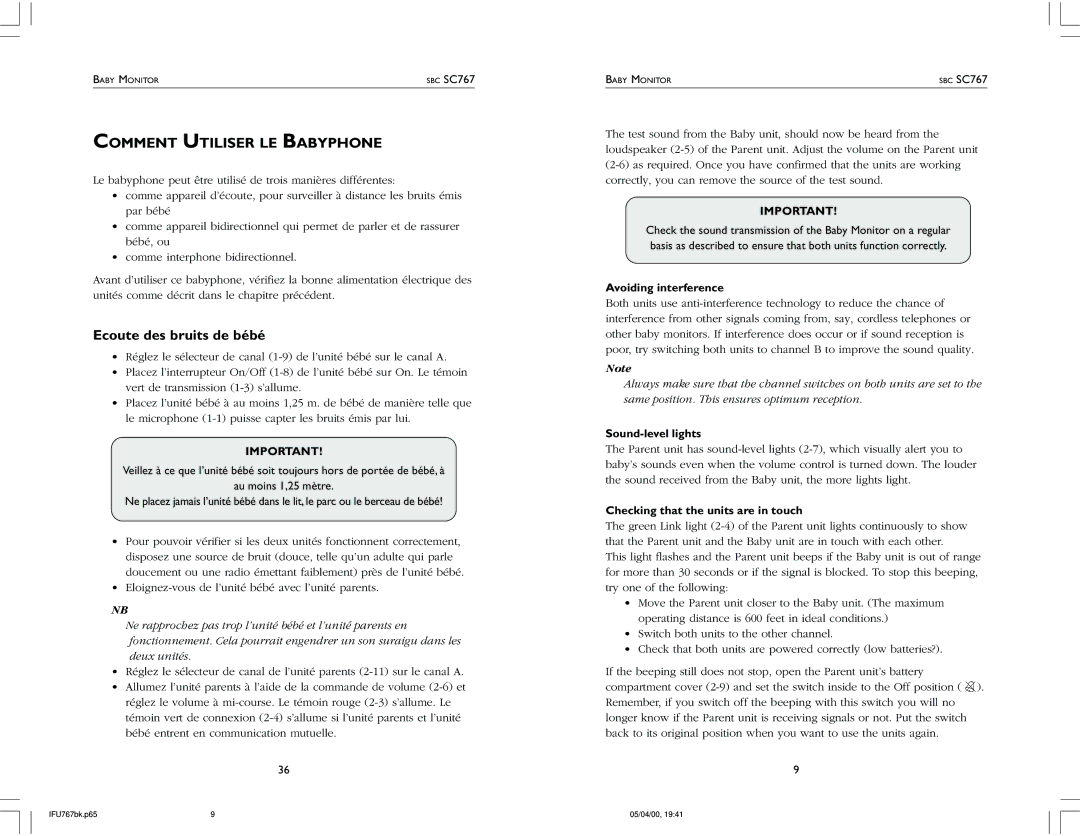
BABY MONITOR | SBC SC767 |
COMMENT UTILISER LE BABYPHONE
Le babyphone peut être utilisé de trois manières différentes:
•comme appareil d’écoute, pour surveiller à distance les bruits émis par bébé
•comme appareil bidirectionnel qui permet de parler et de rassurer bébé, ou
•comme interphone bidirectionnel.
Avant d’utiliser ce babyphone, vérifiez la bonne alimentation électrique des unités comme décrit dans le chapitre précédent.
Ecoute des bruits de bébé
•Réglez le sélecteur de canal
•Placez l’interrupteur On/Off
•Placez l’unité bébé à au moins 1,25 m. de bébé de manière telle que le microphone
IMPORTANT!
Veillez à ce que l’unité bébé soit toujours hors de portée de bébé, à
au moins 1,25 mètre.
Ne placez jamais l’unité bébé dans le lit, le parc ou le berceau de bébé!
•Pour pouvoir vérifier si les deux unités fonctionnent correctement, disposez une source de bruit (douce, telle qu’un adulte qui parle doucement ou une radio émettant faiblement) près de l’unité bébé.
•
NB
Ne rapprochez pas trop l’unité bébé et l’unité parents en fonctionnement. Cela pourrait engendrer un son suraigu dans les deux unités.
•Réglez le sélecteur de canal de l’unité parents
•Allumez l’unité parents à l’aide de la commande de volume
36
BABY MONITOR | SBC SC767 |
The test sound from the Baby unit, should now be heard from the loudspeaker
IMPORTANT!
Check the sound transmission of the Baby Monitor on a regular basis as described to ensure that both units function correctly.
Avoiding interference
Both units use
Note
Always make sure that the channel switches on both units are set to the same position. This ensures optimum reception.
Sound-level lights
The Parent unit has
Checking that the units are in touch
The green Link light
This light flashes and the Parent unit beeps if the Baby unit is out of range for more than 30 seconds or if the signal is blocked. To stop this beeping, try one of the following:
•Move the Parent unit closer to the Baby unit. (The maximum operating distance is 600 feet in ideal conditions.)
•Switch both units to the other channel.
•Check that both units are powered correctly (low batteries?).
If the beeping still does not stop, open the Parent unit’s battery compartment cover ![]() ). Remember, if you switch off the beeping with this switch you will no longer know if the Parent unit is receiving signals or not. Put the switch back to its original position when you want to use the units again.
). Remember, if you switch off the beeping with this switch you will no longer know if the Parent unit is receiving signals or not. Put the switch back to its original position when you want to use the units again.
9
IFU767bk.p65 | 9 | 05/04/00, 19:41 |
